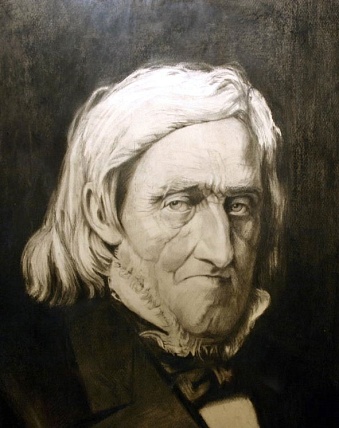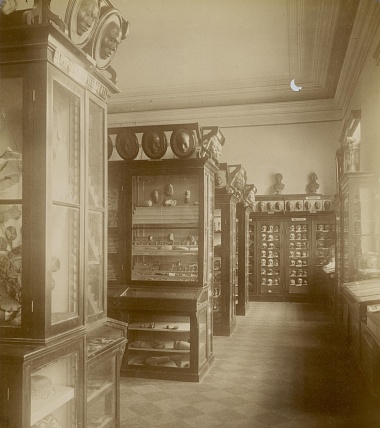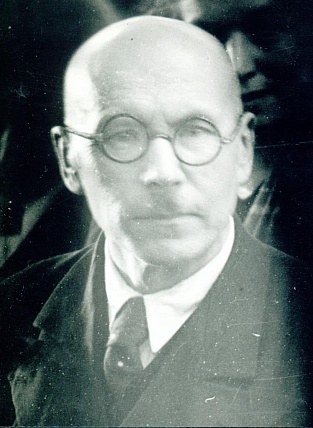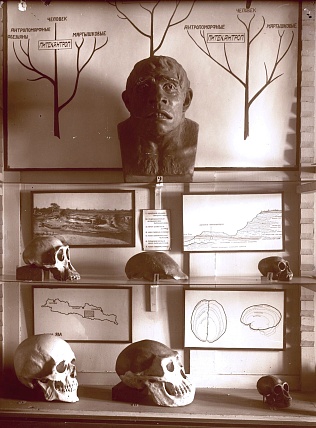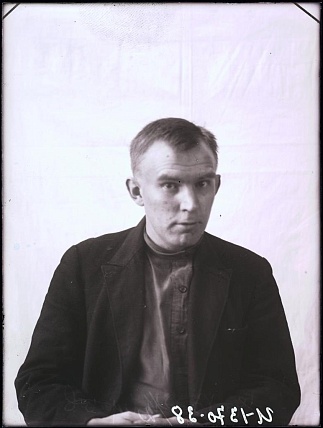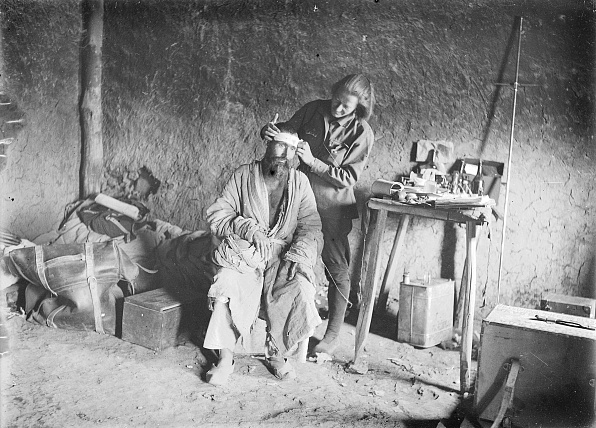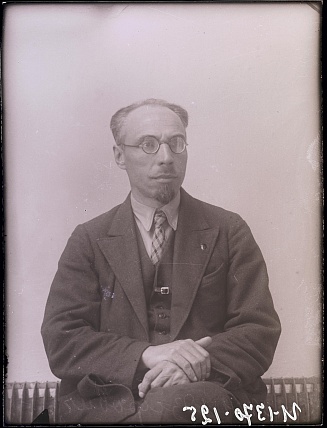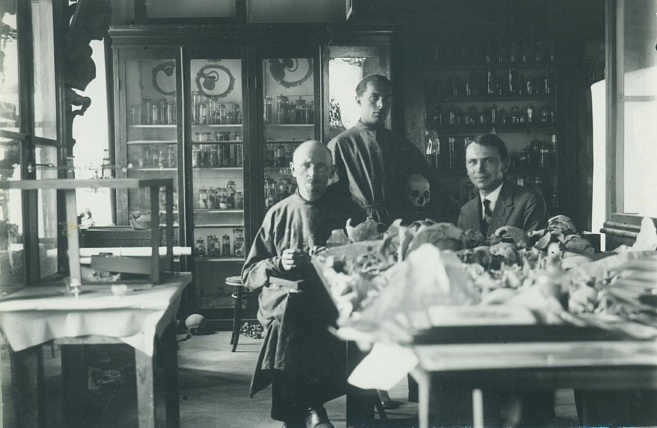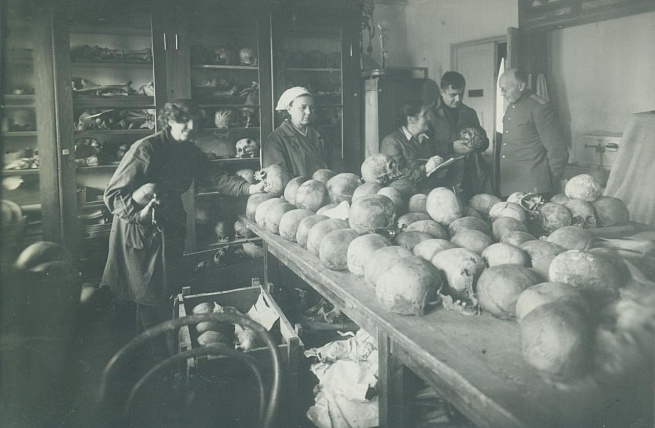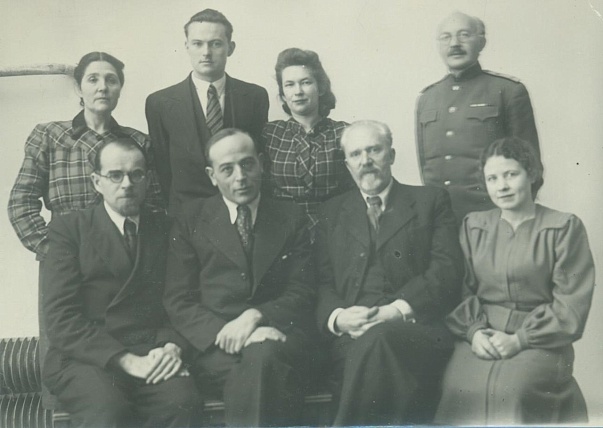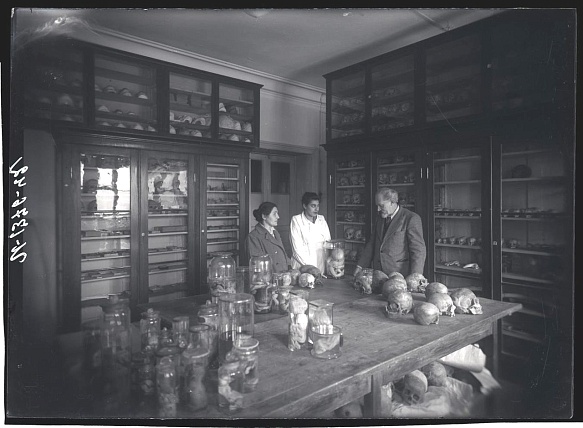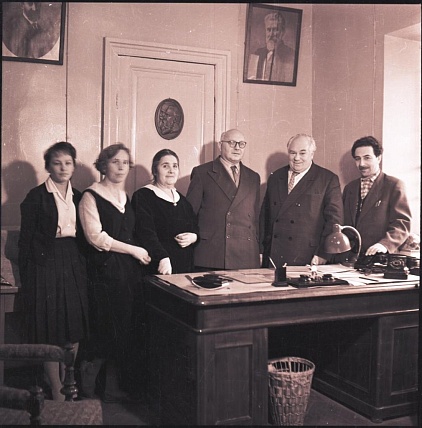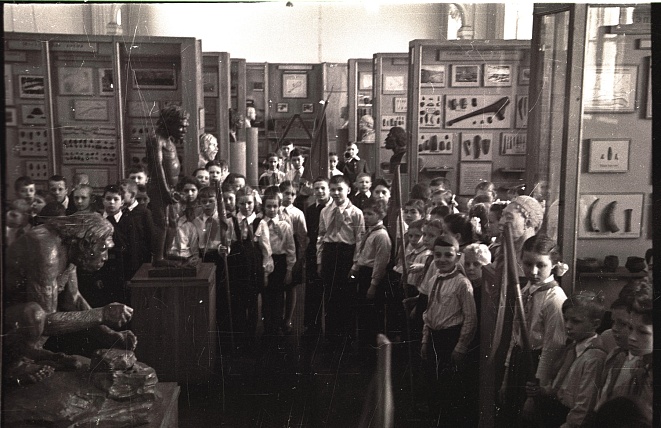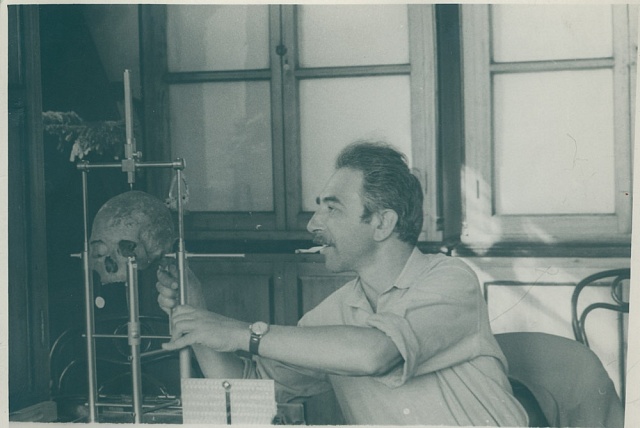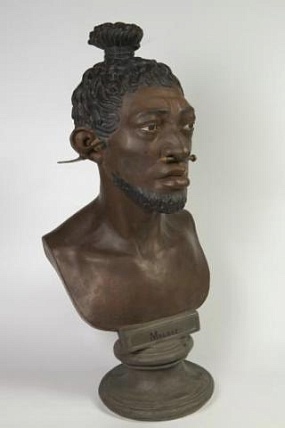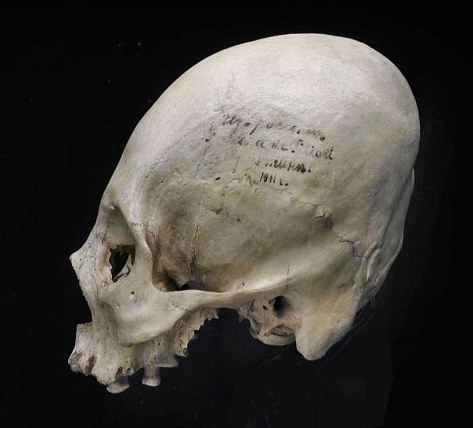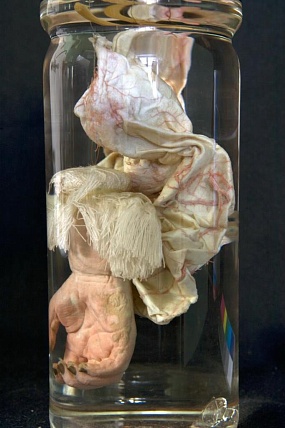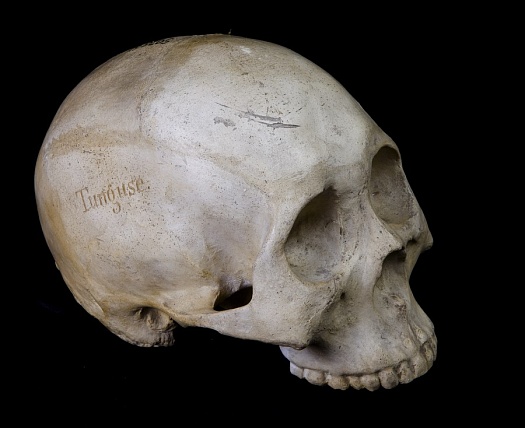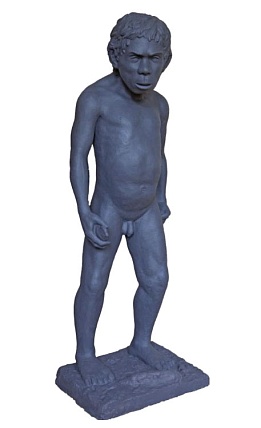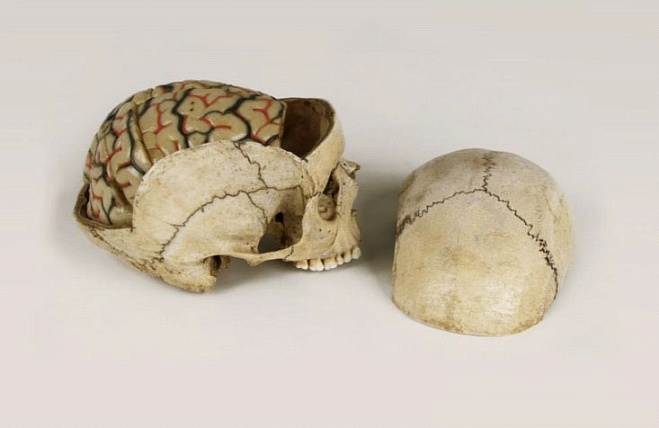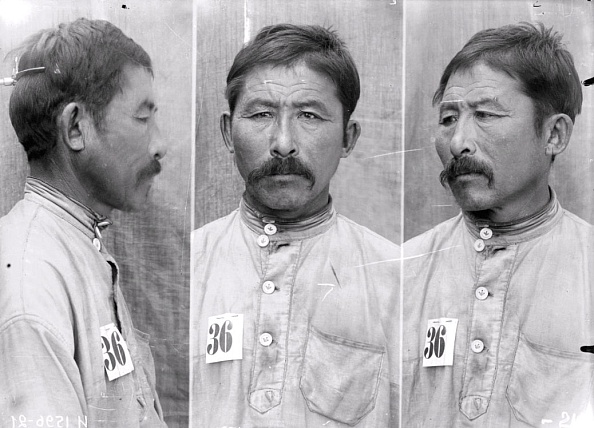- Administration
- Research Departments
- Department of Australia, Oceania and Indonesia
- Department of America
- Department of Physical Anthropology
- Department of Archeology
- Department of Africa
- Department of East and Southeast Asia
- Department of Caucasus
- Department of Siberia
- Department of Central Asia
- Department of South and Southwest Asia
- Department of the History of Kunstkamera and 18th-century Russian Science (M.V. Lomonosov museum)
- Laboratory "The International Center of Islamic Studies"
- Arctic Research Center
- Laboratory of Museum Technologies
- Europe Research Center
- Management and Museum Services
Department of Physical Anthropology
Contact Information
Address: 24 Sredniy Prospekt, Vasilievsky Island, St. Petersburg
Phone:+7 (812) 323-34-19, +7 (812) 323-40-16, (812) 323-27-19
E-mail: bioanthropology@kunstkamera.ru
Department Staff
Valery KHARTANOVICH, Head of Department, Candidate of Sciences, (craniology, paleoanthropology, anthropological composition and origins of ancient and current population of the north of Eastern Europe and West Siberia).
Andrey GROMOV, Senior Researcher, Candidate of Sciences, (physical anthropology, craniometry, osteometry, geometrical morphometry, paleodemography, methodology of anthropological research, artificial cranial deformation).
Alexei KAZARNITSKY, Junior Researcher, Candidate of Sciences (anthropology of the steppe zone of Eurasia; cranial deformation paleodemography).
Alexander KOZINTSEV, Chief Researcher, Doctor of Sciences (physical and cultural anthropology, ethology).
Vyacheslav MOISEEV, Senior Researcher, Candidate of Sciences (anthropology of population of Northern Eurasia, origin of Uralic Speaking peoples, intersystem and interdisciplinary comparisons)
Olga PANARINA, Lead Curator (curator in charge of anatomic, illustrative, and photo materials collections).
Anna RADZJOEN, Lead Curator (academic curation of anatomic collections and Frederik Ruysch collections, museology, history of anatomy, popularization of the Kunstkamera’s museum collections).
Vera SELEZNEVA, Lead Curator, Candidate of Sciences (curator in charge of cranio-osteological collections, museology, museum accounting and storage management; museum educational programs).
Ivan SHIROBOKOV, Researcher, Candidate of Sciences (paleoanthropology, dermatoglyphics , origin of peoples of European Russia).
Evgenia UCHANEVA, Lead Curator (origin of peoples of South Siberia by paleoanthropological data).
Alisa ZUBOVA, Senior Researcher, Candidate of Sciences (dental system morphology analysis of ancient and current population of the Old and New World. Interspecies differentiation of odontologic systems within the Homo genus; taxonomic hierarchy of odontologic systems of ancient and current representatives of the Homo sapiens species. Migration processes in primeval populations of Eurasia. Reconstruction of paleo diet and of other aspects of life of ancient populations on the basis of odontological data; paleoecological research).
History of the Department
The Department of Physical Anthropology is one of the Museum’s oldest research departments.
The precursor of the Museum’s Anthropology Department as such was the Anatomic Cabinet of the Imperial Academy of Sciences. Initially it contained the collection on human and animal anatomy of Frederik Ruysch (1638-1731) purchased by Peter I in 1716, and the teratological collection assembled under the edict of Peter I “On Bringing Newborn Freaks of Nature, and Curious Things Found” published in 1718.
In 1842, Karl Ernst von Baer, member of the St. Petersburg Imperial Academy of Sciences for the chair of zoology (1792-1876), was appointed director of the Anatomical Cabinet of the Imperial Academy of Sciences. By the date of Baer’s entry into office, the Academy had already owned skulls collected by physicians in Russian provinces and in Russian sea and land expeditions, or found in archeological excavations.
For instance, as early as in 1811 the Imperial Academy of Sciences laid the foundation of systematic acquirement of osteological material: by the instruction of the Medical Department of the Ministry of Police, provincial medical offices were to send skulls of various ethnicities to the Academy of Sciences for the collection of skulls of the Russian Empire’s peoples being set up in the Academy’s Museum.
By the 1840s, Academician P. I. Köppen, statistician and ethnographer (1793-1864) had laid the foundation of preservation of craniological material from excavations of ancient burials.
Such collections were assembled to study the peoples inhabiting the Russian State, and their history.
Later, due to Baer’s initiative, the acquirement of craniological material, somatological measurements, and making reliable anthropological portraits of representatives of various peoples, first graphic and cast of gypsum, and later also photographic, were systemized, becoming part of many field explorations. Such were, for example, the Siberian expeditions of zoologist A. F. Middendorf (1842-1845), ethnographer and linguist M. A. Castrèn (1845-1849), and Hungarian researcher A. Reguli (1843-1845).
In 1858, Karl Baer published a vast work on the history and collectors of the craniological collection of the St. Petersburg Academy, and on importance of craniology in archeological surveys. The article appealed for augmentation of the Academy’s craniological collection necessary not only for ethnographic study of the Empire’s multiple peoples, but primarily for research into the national history. “Without doubt,” Baer insisted, “there is no country where an ample collection of skulls would be of such interest and so important for the study of its past like Russia.”
Karl Baer was one of the champions of setting up a Museum of Anthropology and Ethnography of the Academy of Sciences. The museum was intended to unite the Museum of Ethnography and the Anatomical Cabinet of the Imperial Academy of Sciences established in 1836 on the basis of the Academy’s Kunstkamera collections. On November 10, 1879 the establishment of the Museum of Anthropology and Ethnography was approved by the State Council. The anthropological exhibition, the principles of which were laid down by Karl Baer, consisted of an osteological department, plastic reproductions of anthropological types, and photographs of various peoples.
After Baer’s death, the anthropological studies moved primarily to the Russian Anthropological Society of the St. Petersburg University and to the Anthropological Society of the Military Medical Academy. But the Academy of Sciences, too, continued to receive collections that were processed, studied, and catalogued by N. M. Mogilyansky (1871-1933), Yu. V. Ludewig, and K. Z. Yatsuta (1876-1953).
In 1923, the Museum’s Department of Anthropology was headed by B. N. Vishnevsky (1891-1965). In the 1920s and 1930s, among the Department’s researchers were V. V. Ginzburg (1904-1969), Ye. V. Zhirov (1908-1942), G. I. Petrov (1903-1942), and A. N. Yuzefovich (1892-1941). Physical development and stature of human body was studied. In 1927, the Office for Anthropological Study of Blood Groups of Peoples of the USSR was established on the initiative of B. N. Vishnevsky, closely related to practical medicine and genetics, and first expedition acquirements of these data were arranged in Chuvashia, Central Asia, and Belorussia. By the 1930s, the anthropologists joined the Governmental Program for studies of man and peoples as the nation's productive force. In 1931, the Buryat-Mongolian anthropological expedition was conducted in order to study half-castes. In 1932, the Polesye anthropological expedition and Tajik-Pamir expedition were made. The anthropological study of Tajikistan’s population was continued by physician and anthropologist V. V. Ginzburg in 1933, 1936, and 1939.
Ye. V. Zhirov and researchers under his direction systemized the anthropological collections, ascertaining the provenance of many valuable collections and setting up a registration and storage system. Zhirov personally made about 500 scientific schedules of the Department of Anthropology’s collections, and all paleoanthropological materials requiring restoration were totally restored (about 5000 items).
Mirzadjan Baikeyev (1868-1941), graduate of the Baron Stieglitz Central Technical Drawing School and first professional Tatar sculptor, worked with the Department from 1932 till 1938 as sculptor and conservator. For the Department, Baikeyev made gypsum masks of representatives of various ethnicities, gypsum casts of masks, and skull replicas; he restored bone material, and in particular of paleoanthropological objects from burials in Eski-Kermen and Mangup.
In the World War II, the Department lost nearly all of its employees. Researchers Ye. V. Zhirov (d. 1942), G. I. Petrov (d. 1942) and A. N. Yuzefovich (d. 1941) died during the siege of Leningrad. Research technicians M. G. Gostilovskaya (1911 - ?) and G. G. Bayevich (1913 - ?) were dismissed for redundancy in August 1941, and their subsequent fate is unknown.
In the late 1930s the Department was headed by prominent anatomist and anthropologist V. V. Ginzburg (1904-1969), Professor of the Military Medical Academy, Ginzburg headed the department, intermittently, until 1969 (1938-1941, 1944-1950, 1959-1969). Back from the war, Ginzburg began to restore the Department’s personnel strength. For instance, B. V. Firshtein (1908-1985), indologist by her initial education, was transferred to the Department from the India Dept. In 1947, V. P. Yakimov (1912-1982) came to MAE RAS from the Leshaft Natural Research Institute to serve as junior researcher in 1947-1949, academic secretary in 1949-1954, and head of the anthropology sector, Leningrad Branch of the Ethnography Institute of the USSR Ac. of Sc. in 1954-1958. V. V. Bunak (1891-1979), one of the founders of Soviet and Russian anthropology, was transferred to Leningrad in 1948, where he worked in the Department of Anthropology until 1955. In 1956, Ilya Iosifovich Gohman (1928-2008) entered the postgraduate program of the Leningrad Branch, Ethnography Institute of the USSR Ac. of Sc. (currently MAE RAS). The Department employed skilled research technologists Ye. S. Ryazantseva and A. P. Martynova.
Anthropology research in Leningrad was in close contact with scientists from Moscow, and with leading Soviet anthropologists. M. M. Gerasimov (1907-1970) who developed his own method of cranium-based plastic reconstructions, started working in close contact with the Department in the late 1930s. In 2007 the exhibition “Our Ancestors’ Faces. For the 100th Anniversary of M. M. Gerasimov” was arranged, and an exhibition catalogue was published, titled “Our Ancestors’ Faces. For the 100th Anniversary of M. M. Gerasimov” ed. by Yu. K. Chistov and V. I. Selezneva, with contributions from A. G. Kozintsev (MAE RAS, St. P., 2007). You may see the virtual version of the exhibition on the Museum’s website. A collection of Gerasimov’s works from the Department’s collections is presented in the online catalogue “Mikhail Gerasimov: Facial Reconstruction from the Crania.”
“Paleoanthropology of the USSR” (1948), a treatise by G. F. Debets basic for Soviet and Russian paleoanthropology, was in preparation from the late 1930s, largely on paleoanthropological materials of MAE RAS, as well as a later classical treatise titled “Anthropological Research in Kamchatka Oblast” (1951). M. S. Akimova, M. G. Levin, and N. N. Cheboksarov frequently visited the Department to work with paleoanthropological collection and participate in academic events.
Anthropologist and archeologist G. A. Bonch-Osmolovsky (1890-1943) used the Department’s collections to issue the first detailed paper on Neanderthal anatomy – “Palm of the Fossil Human from the Kiik-Koba Grotto” (1941), “Crimean Paleolithic. Foot and Leg Skeleton of the Fossil Human from the Kiik-Koba Grotto” (1954).
Radiologist D. G. Rokhlin, founder of Soviet paleopathology, Professor of the 1st Pavlov Medical Institute in Leningrad and Associate Fellow of the Academy of Medical Sciences (1895-1981) collected and studied cases of pathology on osteological materials from artifacts of various epochs, and issued the work “Diseases of Primeval Humans” (1965), which has become a classic.
In the 1960s, the Department staff continued to be enhanced with specialist anthropologists. Yu. D. Benevolenskaya (1937-2011) entered in 1961, upon graduation from the Faculty of Biology of the Moscow University. A. V. Shevchenko (1937-2004) and A. G. Kozintsev began postgraduate studies in 1968; A. B. Radzyun, postgraduate of the anthropology chair, Faculty of Biology of the Moscow University moved in from Moscow. And in 1969, the Department was headed by I. I. Gohman (1928-2008) who built the Department in its today’s shape: an immense fund of osteological and other collections was set in order, intense acquisition of new collections and their registration and academic study was ensured. Today, most of the Department’s personnel are Gohman’s students of the chairs of ethnography/anthropology of the St. Petersburg University, archeology, and as MAE postgraduates. In 2008, Gohman was awarded the Academician Alekseev Prize of the RAS for outstanding achievements in the development of Russian anthropology. At the same time, the essential sectors of research by personnel of the Department of Physical Anthropology emerged, to remain in place up to this day. In the pre-war, and especially post-war time, planned large-scale archeological efforts were launched in the Soviet Union. In archeological digs, researchers began to find abundant osseous remains (paleoanthropological materials) of primeval humans, a large part of which went to MAE RAS for storage and study. Thus, in the late 1930s, diverse aspects of study of ancient human bone remains became the core of the scientific, expedition, museum acquirement, and curation activity of the Department along with the studies of modern peoples.
The reserve collections consist of several sections:
1. Anatomic collection of Frederik Ruysch and teratological collection.
2. Gypsum casts of osseous materials of primeval humans and ancestors of man. Gypsum busts and masks of representatives of various peoples of the world. Plastic sculptural reconstructions of ancestors of man, ancient humans of various epochs, and historical figures made by Professor M. M. Gerasimov.
3. Photo portraits of representatives of various peoples of the world.
4. The largest collections are those of bone human remains of various ages, from the Upper Paleolithic to that close to our days, originating from archeological digs and handed to MAE RAS by Russian and international travelers/collectors. The most known of them are Upper Paleolithic human remains from the Kostyonki 14 and Kostyonki 15 sites (Voronezh Oblast). Bone materials of the Stone Age from sepulchers of Southern Oleniy Island (Lake Ladoga, Karelia), Vovnigi (Ukraine), Verkholensky (Baikal Land) and many other sepulchers.
Essential topics of research
The Department of Physical Anthropology is one of Europe’s oldest research centers for anthropology of ancient and today’s mankind. The domain of essential scientific interest for the Department personnel comprises anthropogenesis, ethnic anthropology and genesis of peoples of Russia and the world, anthropological research methods, history of anthropology, and museology. Among the core research sectors in the Department are ethnic craniometry and cranioscopy, integration of data from various systems of anthropological characters, and study of biological and cultural factors of human behavior.
In recent years, the following research projects were developed: 2009 – 20011, “Cultural and biological aspects of development of mankind; research subject area: “Modern and ancient population in the Old and New World.” 2012 – 2016, “Ethnic history and cultural heritage of ancient and modern peoples of the world,” research subject area: “Anthropogenesis, cultural genesis, paleoecology, and generation of the anthropological composition of ancient and modern population.” Since 2017, the Department personnel have been conducting research under the interdepartmental research project “Generation of the ancient and modern population of Eurasia and America according to data of ethnology, physical anthropology, and archeology.”
The Department took active part in the implementation of Fundamental Research Programs of the RAS Presidium: 2003 – 2005, “Ecology and subsistence of Eurasian peoples,” with the project “Historical anthropology of human populations in Northern Eurasia” (on materials of the MAE RAS collections and databases); 2006 – 2008, “Adaptation of peoples and cultures to environmental variations and to social and man-made transformations,” with the project “The making of anthropological communities and local versions of the population of Eastern Europe, Siberia, and Far East”; 2009 – 2011, “Historic and cultural heritage and spiritual values of Russia,” with the project “Anthropological collections of MAE RAS as a source for studies of the genesis of peoples of north-western Russia”; 2012–2014, “Traditions and innovations in history and culture,” with the project “Continuity and transformations in the development of ancient and medieval human populations in the north of European Russia: Substrate groups and migrations.”
Original unique methods of material analysis have been developed. Of key importance is development and verification, on contributors' own materials, of new methods of anthropological material analysis. In recent years, new sectors have been actively developing, such as geometrical morphometry. The researchers apply an integrated approach to the study of paleoanthropological data by joint developments with scientists of related disciplines, e.g. geneticists, archeologists, and paleozoologists. The research is in close collaboration with anthropologists of Russia’s leading scientific centers: IEA RAS, IA RAS, Research Institute and Museum of Anthropology of the Moscow University, and others. Joint integrated research and expedition programs are being implemented. Collaboration with scientists outside Russia is constant.
The basic achievements of the Department’s research and museum activities consist in preservation and development of traditional, long-standing lines of research, primarily in paleoanthropology. New paleoanthropological materials on ancient population of Eurasia have been gathered and introduced into scientific discourse; American continent settlement routes in primeval ages, and features of generation of the anthropological composition in that continent have been studied. The population history of ancient and current population of Fennoscandia, the Baltic States, European Russia, and the Russian Arctic has been reviewed. Differentiation of the population of European Russia and the Kama Region has been studied from the Iron Age and mid-1st millennium up to that close to our days. The problems of generation of the anthropological composition of South Siberia’s population in the early Iron Age and at the BC/AD break in the south of Russia have been studied on the basis of craniometric and osteometric materials. The problem of variability ratio of the obsequies and craniological data has been studied for the population of Eastern Europe in the Bronze Age and the steppe belt of Northern Eurasia in the early Iron Age.
In recent years, agreements on scientific cooperation in the reconstruction of history of human societies on the basis of the MAE RAS paleoanthropological collections were signed between MAE RAS and Centre for GeoGenetics, Natural History Museum of Denmark, University of Copenhagen; Harvard University, Max-Planck-Institut für evolutionäre Anthropologie in Leipzig, College of the Holy and Undivided Trinity of Queen Elizabeth near Dublin, and other leading international research teams. The Department’s personnel, as part of international research teams, started wide-scale joint efforts in integrated anthropological and genetic (bone DNA) research into the population history of Eurasia’s population. Several joint scientific papers have been published in major magazines outside Russia, such as Nature, Science, PLoS Genetics, and Cell.
Essential Publications
- Godina E., Butovskaya M., Kozintsev A. The History of Biological Anthropology in Russia and the Former Soviet Union . Newcastle-upon-Tyne, 1993.
- Kozintsev. A. The Mirror of Laughter. New Brunswick and London: Transaction, 2010. 235 p.
- Kozintsev A.G. Kukly: rage and jest // Uncensored? Reinventing Humor and Satire in Post-Soviet Russia. Bloomington: Slavica, 2008. P. 183-199.
- Kozintsev A.G. Stalin jokes and humor theory // Russian Journal of Communication. 2009. Vol. 2, № 3-4. P. 199-214.
- Moiseyev V.G. Origins of Uralic-speaking Populations: Cranial Evidence //HOMO - Journal of Comparative Human Biology. 2001. V. 52. № 3. Pp. 240-253.
- Moiseyev V.G. Northern Eurasian populations: Linguistic versus Biological Differentiation // Archaeology, Ethnology and Anthropology of Eurasia, № 4, 2001. P. 154-159.
- Moiseyev V.G. Nonmetric traits in early Iron Age cranial series from Western and Southern Siberia // Archaeology, Ethnology and Anthropology of Eurasia, № 1 2006. P. 145-152.
- Moiseyev V.G. On the origin of Okhotsk populations of Northern and Eastern Hokkaido: cranial evidence // Archaeology, Ethnology and Anthropology of Eurasia, № 1. 2008, P. 134-141.
- Belyaeva V.I., Moiseyev V.G. Statistical analysis of Kostenki shouldered points: a trial // Archaeology, Ethnology and Anthropology of Eurasia. 2007. № 3. P. 16-28.
- Moiseyev V.G. On the origin of the Ryukyu islanders the integration of craniometric and cranial nonmetric data // Archaeology, Ethnology and Anthropology of Eurasia. 2009. № 4. P. 146-152.
- Moiseyev V.G., Khartanovich V.I. Early Metal Age Crania from Bolshoy Oleniy Island, Barents Sea // Archaeology, Ethnology and Anthropology of Eurasia. 2012. № 1. P. 145-154.
- M.V. Dobrovolskaya, A.P. Buzhilova, M.B. Mednikova,, A.V. Tiunov V.I. Seleznyova, V.G. Moiseyev and V.I. Khartanovich A Palaeodietry Investigation of Carbon (13C/12C) and Nitrogen (15N/14N) Stable Isotopes in Human Bone Collagen from Early Iron Age Burials at Aimyrlyg, Tuva // The 18th Annual Meeting of the European Association of Archaeologists. August 29 - September 1, 2012. Helsinki – Finland. P. 162.
- Vyacheslav Moiseyev and Valery Khartanovich. Ancient Human Migrations from Siberia to Fennoscandia: Cranial Evidence // The 18th Annual Meeting of the European Association of Archaeologists. August 29 - September 1, 2012. Helsinki – Finland. P. 163
- Clio Der Sarkissian, Alan Cooper, Wolfgang Haak, Oleg Balanovsky,Valery Zaporozhchenko, Elena Balanovska, Guido Brandt, Kurt W. Alt, Valery Khartanovich, VyacheslavMoiseyev,, Alexandra Buzhilova, Sergey Koshel (Moscow State University, Russia), Vladimir Shumkin, Eugen Kolpakov. Ancient Mitochondrial DNA from Archaeological Sites in North-east Europe Unravels Complex Human Population History // The 18th Annual Meeting of the European Association of Archaeologists. August 29 - September 1, 2012. Helsinki – Finland. P. 164.
- Clio Der Sarkissian, Oleg Balanovsky, Guido Brandt, Valery Khartanovich, Alexandra Buzhilova, Sergey Koshel, Valery Zaporozhchenko, Detlef Gronenborn, Vyacheslav Moiseyev, Eugen Kolpakov, Vladimir Shumkin, Kurt W. Alt, Elena Balanovska, Alan Cooper, Wolfgang Haak, the GenographicConsortium. Ancient DNA Reveals Prehistoric Gene-Flow from Siberiain the Complex Human Population History of North East Europe // PLOS Genetics,| www.plosgenetics.org, 1 February 2013. Volume 9, Issue 2, e1003296.
- Anna Radziun, Yuri Chistov. The first scientific collections of Kunstkamera. Saint-Petersburg, 2012. P.3-79.
- Shirobokov I.G. Age estimation, sexual dimorphism and inter-population variability studies in paleodermatoglyphics: pros and cons // 18th annual meeting of European Association of archaeologists. Abstracts. Helsinki, 2012. P. 163.
Papers in Russian
- Antropologiya sovremennogo i drevnego naseleniya Yevropeiskoi chasti SSSR [Anthropology of the contemporary and ancient population of the European USSR] / Ed. by I. I. Gohman, A. G. Kozintsev. Leningrad: Nauka, 1986. 224 pp.
- Gohman I. I. Naseleniye Ukrainy v epokhu mezolita i neolita (antropologicheskiy ocherk) [The population of Ukraine in the Mesolithic and Neolithic, an anthropological essay]. Moscow: Nauka, 1966, 224 pp.
- Gohman I. I., Alekseev V. P. Antropologiya Aziatskoi chasti SSSR [Anthropology of the Asian USSR]. Moscow, 1984, 208 pp.
- Kozintsev A.G. Etnicheskaya kranioskopiya. Rasovaya izmenchivost’ shvov cherepa soveremennogo cheloveka [Ethnic cranioscopy. Racial variability of cranial sutures of modern man]. St. P.: Nauka, 1988.
- Kozintsev A.G. Chelovek in smekh [Man and Laughter]. St. Petersburg: Aleteya, 2007.
- Novye kollektsii i issledovaniya po antropologii SSSR [New collections and research efforts in the USSR anthropology] / ed. by I. I. Gohman. Nauka, Leningrad, 1991, 216 pp. (Сборник МАЭ. Т. XLIV).
- Nekotorye aktualnye problemy sovremennoi antropologii [Some present-day problems of modern anthropology] / ed. by I. I. Gohman, A. V. Gromov. MAE RAS, St. Petersburg, 2006.
- Paleoantropologiya, etnicheskaya antropologiya, etnogenez. K 75-letiyu Ilyi Iosifovicha Gohmana [Paleoanthropology, ethnic anthropology, and ethnogenesis. For the 75th anniversary of Ilya Iosifovich Gohman] / ed. by Kozintsev A.G. St. Petersburg: MAE RAS, 2004, 246 pp.
- Problemy antropologii drevnego i sovremennogo naseleniya Yevrazii [Problems of anthropology of the ancient and modern population of Eurasia] / ed. by I. I Gohman. L.: Nauka, 1984, 160 pp.
- Chistov Yu. K. Antropologiya drevnego i sovremennogo naseleniya Yuzhnogo Yemena. Ch. I. Paleoantropologiya, antropometriya, antroposkopiya [Anthropology of the ancient and modern population of South Yemen. Pt. I. Paleoanthropology, anthropometry, and anthroposcopy]. St. Petersburg: Evropejskij dom, 1998, 274 pp.
- Mikroevolutsionnye protsessy v chelovecheskikh populyatsiyakh [Micro-evolution processes in human populations / Publication editors: A. V. Gromov, V. I. Hartanovich. St. Petersburg: MAE RAN Press, 2009. 293 pp.
- Gromov A. V., Khodjayov T. K. Paleodemografiya Srednei Azii [Paleodemography of Central Asia]. Moscow: Informatsionnaya tsivilizatsiya – XXI vek, 2009, 352 pp.
- Vasiliev S. A., Beryozkin Yu. Ye., Kozintsev A. G. Sibir i pervye amerikantsy [Siberia and the first Americans] / RAN. IIMK, MAE im. Petra Velikogo (Kunstkamera). St. Petersburg, 2009 (2nd edition in 2011).
- Vasiliev S. A., Beryozkin Yu. Ye., Kozintsev A. G. Sibir i pervye amerikantsy [Siberia and the first Americans]. 2nd edition, as revised and extended: Iskusstvo Rossii, St. Petersburg, 2011, 190 pp.
- Kazarnitsky A. A. Naseleniye azovo-kaspiyskikh stepei v epokhu bronzy (antropologicheskiy ocherk) [Population of the Azov and Caspian steppes in the Bronze Age (an anthropological essay)] / ed. by A. V. Gromov. Nauka, St. Petersburg, 2012, 264 pp.
- Smekh: istoki i funktsii [Laughter: Origins and functions] / ed. by Kozintsev A.G. St. Petersburg: Nauka, 2002.
- Radzyun A. B., Hartanovich M. V. Kunstkamera Peterburgskoi akademii nauk XVIII v.: u istokov antropologicheskikh znaniy v Rossii [Kunstkamera of the St. Petersburg Academy of Sciences in the 18th century: At the origins of anthropological knowledge in Russia] // Bulletin of the Moscow State University. Series XXIII. Anthropology. 2015, No. 2, pp. 114–122.
Of the articles published by the Department’s staff in recent years, the most important are:
- Gromov A. V. Proiskhozhdeniye i svyazi okunevskogo naseleniya Minusinskoi kotloviny [Origins and relations of the Okunev population of the Minusinsk Depression] // Okunevskiy sbornik. St. Petersburg, 1997, pp. 301-345.
- Gromov A. V. (jointly with A. G. Kozintsev and V. G. Moiseev). Novye dannye o sibirskikh amerikanoidakh [New data on Siberian Americanoids] // Arkheologiya, etnografiya i antropologiya Yevrazii. Vol. 3(15). Novosibirsk, 2003, pp. 146-154.
- Gromov A. V. Drevneye naseleniye doliny r. Sumbar (Yugo-Zapadnyi Turkmenistan) [Primeval population of the Sumbar River Valley (South-western Turkmenistan]// Paleoantropologiya, etnicheskaya antropologiya, etnogenez. St. Petersburg, 2004, pp. 8-20.
- Gromov A. V. Ob osobom tipe detskikh pogrebeniy v mogilnikakh chervnovskogo etapa okunevskoi kultury [On a special type of child burials in sepulchers of the Chernov stage of the Okunev culture] // Okunevskiy sbornik 2. St. Petersburg: Alexis Print, 2006.
- Gromov A. V. Cherepa iz Osinkinskogo mogilnika: sledy iskusstvennogo vozdeistviya [Skulls from the Osinkino burial: Traces of artificial impact] // Opus: Mezhdistsiplinarnye issledovaniya v arkheologii. Moscow: Izd-vo IA RAN, 2006, Issue 5.
- Gromov A. V. (jointly with I. I. Gohman) Tesinskiy gruntovyi mogilnik Kamenka III: dannye kraniometrii I kranioskopii [Kamenka III, a Tes’ earth burial: Craniological and cranioscopic data] // Arkheologiya, etnografiya i antropologiya Yevrazii. Novosibirsk, 2009, No. 1, pp. 136-145.
- Gromov A. V. (jointly with T. K. Khodjayov) Paleodemografiya Srednei Azii [Paleodemography of Central Asia]. Moscow: izd-vo “Informatsionnaya tsivilizatsiya – XXI vek,” 2009, 352 pp.
- Gromov A. V. “Collateral relatives of American Indians among the Bronze Age populations of Siberia?” (jointly with A. G. Kozintsev and V. G. Moiseev) // American Journal of Physical Anthropology, 1999, vol. 108, № 2, pp. 193-204.
- Kazarnitsky A. A. Kraniologiya naseleniya maikopskoi kultury: “novye starye materially” [Craniology of the Maikop culture population: “New old materials”] // Arkheologiya, etnografiya i antropologiya Yevrazii, No. 1, 2010, pp. 148-155.
- Kazarnitsky A. A. Kraniologiya lolinskoi kultury [Craniology of the Lola culture] // Vestnik arkheologii, antropologii i etnografii, No. 1 (12), 2010, pp. 132-140.
- Kazarnitsky A. A. Kranioskopiya naseleniya azovo-kaspiyskikh stepei Predkavkazya v period rannei I srednei bronzy [Cranioscopy of the population of Azov and Caspian Ciscaucasian steppes in the Early and Middle Bronze] // Bulletin of the Moscow State University. Series XXIII. Anthropology. No. 1, 2011, pp. 76-83.
- Kazarnitsky A. A. Naseleniye epokhi bronzy v stepyakh Severo-Zapadnogo Prikaspiya [Bronze Age population in the North-Western Caspian steppe] // Zapiski Instituta istorii materialnoi kultury RAN No. 6, 2011, pp. 133-142.
- Kazarnitsky A. A. Novye kraniologicheskiye materialy iz Lipetskogo kurgana №2 (k voprosu o formirovanii stepnogo i lesostepnogo naseleniya Vostochnoi Yevropy v epokhi srednei i pozdnei bronzy) [New craniological materials from Lipetsk burial mound No. 2 (more on the generation of the steppe and wooded-steppe population of Eastern Europe in the Middle and Late Bronze] // Zapiski Instituta istorii materialnoi kultury RAN No. 7, 2012, pp. 74-88.
- Kazarnitsky A. A. Naseleniye azovo-kaspiyskikh stepei v epochu bronzy (antropologicheskiy ocherk) [Population of the Azov and Caspian steppe in the Bronze Age]. St. Petersburg: Nauka, 2012, 264 pp.
- Kazarnitsky A. A. Formirovaniye chelovecheskikh populyatsiy Vostochnoi Yevropy IV-II tys. do n.e. (postanovka problemy) [The making of human populations of Eastern Europe in the 4th – 2nd millenium BC (problem statement)] // Radlovskiy sbornik. Nauchnye i sledovaniya i muzeinye proekty MAE RAN v 2012 g. St. Petersburg, 2013, pp. 38-51.
- Kazarnitsky A. A. Kraniologiya naseleniya babinskoi kultury [Craniology of the Babino culture population] // Vestnikarkheologii, antropologiiietnografii. Tyumen, No. 2 (21), 2013, pp. 70-78.
- Kozintsev A.G. O roli vostochnoaziatskikh mongoloidov v formirovanii antropologicheskogo sostava naseleniya Yaponii [On the role of East Asian Mongoloids in the generation of the anthropological composition of Japan’s population] // Problemy obscheiiregionalnoi etnografii. St. Petersburg: MAE RAN, 2007, pp. 160-166.
- Kozintsev A.G. Prichernomorskiye skify: mezhgruppovye razlichiya, vneshniye svyazi, proiskhozhdeniye [Pontic Scythians: Intergroup differences, external relations, and genesis] // Arkheologiya, etnografiya i antropologiya Yevrazii. 2007, No. 4 (32), pp. 143-157.
- Kozintsev A.G. O funktsii trikstera [On the trickster function] // AB-60. Sbornik k 60-letiyu A. K. Baiburina. St. P.: European University Press in St. Petersburg, 2007, pp. 325-339.
- Kozintsev A.G. Tak nazyvaemye sredizemnomortsy Yuzhnoi Sibiri i Kazakhstana, indoyevropeiskiye migratsii I proiskhozhdeniye skifov [So-called Mediterraneans of South Siberia and Kazakhstan, Indo-European migrations, and genesis of the Scythians] // Arkheologiya, etnografiya i antropologiya Yevrazii. 2008, No. 4 (36), pp. 153-157.
- Kozintsev A. G. Indoneziytsy, indeitsy i protomorfnye mongoloidy Zapadnoi Sibiri [Indonesians, Indians, and protomorphic Mongoloids of West Siberia] //Indoneziytsy i ikh sosedi. St. P.: MAE RAS, 2008, pp. 332-337.
- Kozintsev A.G. Ob antireferentivnoi funktsii yazyka [On the anti-referential function of language] // Logicheskiy analiz yazyka: mezhdulozhyu I fantaziei. Moscow: Indrik, 2008, pp. 55-66.
- Kozintsev A.G. Rasolog Vladimir Avdeev izuchaet izviliny v mozge vraga [Raceologist Vladimir Avdeev studies gyri in enemy brain] // Kritika rasizma v sovremennoi Rossii inauchnyi vzglyad na problemu etnokulturnogo mnogoobraziya. Moscow: Academia, 2008, pp. 19-40.
- Kozintsev A.G. Kukly: rage and jest // Uncensored? Reinventing Humor and Satire in Post-Soviet Russia. Bloomington: Slavica, 2008, pp. 183-199.
- Kozintsev A.G. O rannikh migratsiyakh yevropeoidov v Sibir i Tsentralnuyu Aziyu (v svyazi s indoyevropeiskoi problemoi [on early migrations of Caucasians to Siberia and Central Asia (as related to the Indo-European Problem) // Arkheologiya, etnografiya i antropologiya Yevrazii. 2009, No. 4 (40), pp. 125-136.
- Kozintsev A.G. Evolutsionnaya istoriya vida Homo sapiens v svete novykh dannykh populyatsionnoi genetiki [Homo sapiens evolution history in view of new data of population genetics] // Bulletin of the Moscow State University. Series XXIII. Anthropology. 2009, No. 4, pp. 64-70.
- Kozintsev A.G. Nauka minus nauka [Science minus science] // Antropologichesky forum. 2009. No. 11, pp. 419-431.
- Kozintsev A. G., Selezneva V. I. Kraniometricheskiye osobennosti naseleniya Tuvy epokhi zheleza [Craniometric features of the population of Tuva in the Iron Age] // Radlovskiy sbornik. St. P.:MAE RAS, 2011, pp. 217-222.
- Kozintsev A. G., Selezneva V. I. O blizkikh i dalnikh rodstvennikakh amerikanskikh indeitsev v Azii [On close and distant relatives of American Indians in Asia] // Radlovskiy sbornik. St. P.: MAE RAS, 2012, pp. 370-378.
- Kozintsev A.G. Iz stepi v pustynyu: ranniye yevropeoidy Vostochnogo Turkestana po dannym genetiki I antropologii [From steppe to desert: Early Caucasoids of East Turkestan according to genetic and anthropological data] // Kultury stepnoi Yevrazii I ikh vzaimodeistviye s drevnimi tsivilizatsiyami. Book 1. St. Petersburg: IIMK RAN, 2012, pp. 122-126.
- Kozintsev A.G. Evolutsionnoye begstvo: S. M. Eizenshtein i estetika komicheskogo [Evolutionary escape: S. M. Eisenstein and aesthetics of the comical] // Kinovedcheskiye zapiski. 2012, No. 101/102, pp. 419-437.
- Kozintsev A.G. Opyt prepodavaniya nekotorykh antropologicheskikh kursov v ramkakh sistemy liberalnogo obrazovaniya [Experience of teaching some courses in anthropology within the liberal education framework] // Problemy liberalnogo obrazovaniya. St. Petersburg: SPbGU, 2012, pp. 64-71.
- Kozintsev A. G. Proiskhozhdeniye and rannyaya istoriya vida Homo sapiens: novye biologicheskiye dannye [Genesis and early history of the Homo sapiens species: New biological data] // Fundamentalnye problemy arkheologii, antropologi i ietnografii Yevrazii. K 70-letiyuakad. A. P. Derevyanko. Novosibirsk, IAEt SO RAN, 2013, pp. 519-535.
- Kozintsev A. G. Rasovaya klassifikatsiya v svete novykh geneticheskikh dannykh [Race classification in view of new genetic data] // Radlovskiy sbornik. St. Petersburg: MAE RAN, 2013, pp. 62-69.
- Moiseev V. G. Severnaya Yevraziya: YAZYKOVAYA DIFFERENTSIATSIYA I DANNYE FIZICHESKOI ANTROPOLOGII [Northern Eurasia: LANGUAGE DIFFERENTIATION AND PHYSICAL ANTHROPOLGY DATA] //Arkheologiya, etnografiya i antropologiya Yevrazii, 2001.
- Moiseev V. G. Proiskhozhdeniye uraloyazychnykh narodov po dannym kraniologii [Genesis of Uralic speaking peoples according to craniology data]. – St. Petersburg: Nauka, 1999, 133 pp.
- Hartanovich V. I. Kraniologiya izhor [Craniology of the Ingrians]// Rasy i narody. Moscow, 2004, Issue 30, pp. 96-124.
- Hartanovich V. I. Novye kraniologicheskiye materialy po saamam Kolskogo poluostrova (mogilnik Severnaya Salma) [New craniological materials on the Sami of the Kola Peninsula] // Paleoantropologiya, etnicheskaya antropologiya, etnogenez. St. Petersburg, 2004, pp. 108-125.
- Hartanovich V. I. Kraniologiya verkhnevychegodskikh I sysolskikh komi [Craniology of the Komi of the Upper Vychegda and Sysola region] // Antropologiyakomi, Moscow, 2006, pp. 233-243.
- Hartanovich V. I. Kraniologicheskiye materialy mogilnika Yuzhnogo Olenyego ostrova Onezhskogo ozera – voprosy nauchnoi restavratsii v svyazi s problemami proiskhozhdeniya naseleniya [Craniological materials from a burial in Yuzny Oleniy Island, Lake Onega: Issues of scientific restauration related to population genesis problems] // Aktualnye problemy razvitiya muzeev-zapovednikov. Petrozavodsk, 2006, pp. 201-214.
- Hartanovich V. I. K izucheniyu proiskhozhdeniya naseleniya i etnicheskoi istorii Vostochnoi Karelii [For the studies of the East Karelia population genesis and ethnic history] // Yestestvenno-nauchnye i gumanitarnye osnovy prirodookhrannoi, nauchnoi i prosvetitelskoi deyatelnosti na okhranyaemykh prirodnykh territoriyakh Russkogo Severa. Petrozavodsk, 2006, pp. 165-176.
- Hartanovich V. I. O “laponoidnosti” na Severe Yevropy (po antropologicheskim materialam iz mogilnikov Bolshogo Olenyego ostrova v Kolskom zalive Barentseva morya i Yuzhnogo Olenyego o-va Onezhskogo ozera) [On the “Lapponoid” phenomenon in the north of Europe (based on anthropological materials from burials of Bolshoi Oleniy Island in the Kola Bay, Barents Sea and of South Oleniy Island, Lake Onega] // Pervobytnaya i srednevekovaya istoriya i kultura Yevropeiskogo severa: Problems of study and scientific reconstruction, 2006. pp. 143-156.
- Hartanovich V. I., Belsky S. V., Laakso V. Monitoring sovremennogo sostoyaniya mogilnikov epokhi Srednevekovya-Novogo vremeni v severo-zapadnom Priladozhye v 2005-2006 godakh (nekotorye rezultaty i perspektivy izucheniya) [Current status monitoring of burials of the Middle Ages/Modern Age in the north-western Ladoga reagion in 2005-2006 (some results and prospects for studies] // IstoriyaikulturnoyenaslediyeSevernogoPriladozhya: vzglyadizRossiiiFinlyandii. Petrozavodsk, 2007, pp. 38-42.
- Hartanovich V. I., Shirobokov I. G. K kraniologii srednevekovogo naseleniya severo-zapadnogo Priladozhya (predvaritelnyi analiz materialov iz mogilnika Kyulalakhti Kalmistomyaki [For craniology of the medieval population of the north-western Ladoga Region (tentative analysis of materials from the Kylalahti Kalmistomäki burial) // Radlovskiy sbornik: Nauchnye issledovaniya i muzeinye proektyv 2007 g. St. Petersburg: MAE RAN, 2008, pp. 222-231.
- Moiseev V. G., Hartanovich V. I., Shirobokov I. G. Kraniologiya pozdnesrednevekovogo naseleniya Vologdy [Craniology of the late medieval population of Vologda] // Bulletin of the Moscow State University. Series XXIII. Anthropology. No. 3, 2012, pp. 94–109.
- Hartanovich V. I., Shirobokov I. G. K probleme formirovaniya antropologicheskogo sostava naseleniya “lopskikh pogostov” (po kraniologicheskim materialam iz mogilnika XVII – nachala XIX veka Alozero) [For the problem of generation of the anthropological composition of the population of “Lapponian settlements” (based on craniological materials from Alozero, a burial of the 17th – early 19th century] // Arkheologiya, etnografiya i antropologiya Yevrazii. Novosibirsk, 2012, No. 2 (50), pp. 141-152.
- Moiseev V. G., Hartanovich V. I. Kraniologicheskiye materialy iz mogilnika epokhi rannego metalla na Bolshom Olenyem ostrove Barentseva morya [Craniological materials from a burial of the Early Metal Age in Bolshoi Oleniy Island of the Barents Sea] // Arkheologiya, etnografiya i antropologiya Yevrazii. Novosibirsk, 2012, No. 1 (49), pp. 145-154.
- Hartanovich V. I., Moiseev V. G. Kraniologicheskiye materialy o proiskhozhdenii drevnego naseleniya krainego severa Yevropy [Craniological materials on the origins of the ancient population of the extreme north of Europe] // Pomorskiye chteniya po semiotike kultury. Geoistoricheskiye i geoetnokulturnye obrazy i simvoly osvoeniya arkticheskogo prostranstva. Sbornik nauchnykh statei. Arkhangelsk, 2012, pp. 128-145.
- Hartanovich V. I., Moiseev V. G., Shirobokov I. G. Bazy dannykh Muzeya antropologii I etnografii im. Petra Velikogo (Kunstkamera) RAN kak istochnik izucheniya antropologicheskogo sostava narodov Rossii (antropologicheskiye materialy iz srednevekovoi Vologdy) [Databases of the Peter the Great Museum of Anthropology and Ethnography (Kustkamera) of the RAS as a source for studies of the anthropological composition of peoples of Russia (anthropological materials from medieval Vologda] // Istoriko-kulturnoye naslediye I dukhovnye tsennosti Rossii. Moscow, 2012, pp. 603-610.
- Hartanovich V. I., Moiseev V. G. Antropologicheskiy sostav drevnego naseleniya Kolskogo poluostrova (po kraniologicheskim materialam iz mogilnika epokhi rannego metalla na Bolshom Olenyem ostrove Barentseva morya) [Anthropological composition of the ancient population of the Kola Peninsula (based on craniological materials from a burial of the Early Metal Age in Bolshoi Oleniy Island of the Barents Sea)] // Mezolit I neolit Vostochnoi Yevropy: khronologiya i kulturnoye vzaimodeistviye. Iz-vo IIMK RAN, MAE RAN, St. Petersburg, 2012, pp. 153–159.
- Hartanovich V. I., Shirobokov I. G. K antropologii naseleniya Severo-Zapadnogo Obonezhya (po kraniologicheskim materialam XVIII – nach. XX vv. iz mogilnika o-va Kizhi) [For anthropology of the population of the North-Western Onega Region (by craniological materials of the 18th – early 20th century from a burial in the Isle of Kizhi] // Aktualnye napravleniya antropologii. Sbornik, posvyaschennyi 80-letiyu akademika RAN T. I. Alekseevoi. Moscow, 2008, pp. 212-221.
- Shirobokov I. G. Dermatoglificheskaya differentsiatsiya karel [Dermatoglyphic differentiation of the Karelians] // Aktualnye napravleniya antropologii. Sbornik, posvyaschennyi 80-letiyu akademika RAN T. I. Alekseevoi. Moscow, 2008, pp. 239-248.
- Shirobokov I. G. Territorialnaya izmenchivost karel: integratsiya dannykh dermatoglifiki i kraniologii [Territorial variability of the Karelians: Integration of dermatoglyphic and craniological data] // Radlovskiy sbornik. Nauchnye issledovaniya i muzeinye proekty MAE RAN v 2008 g. St. Petersburg, 2009, pp. 114-120.
- Shirobokov I. G. Antropologicheskiy sostav karel po dannym dermatoglifiki [Anthropological composition of the Karelians according to dermatoglyphic data] // Mikroevolutsionnye protsessy v chelovecheskikh populyatsiyakh. St. Petersburg, 2009, pp. 268-293.
- Shirobokov I. G. Chastota radialnykh uzorov: novyi dermatoglificheckiy priznak i yego taksonomicheckiye znacheniye dlya differentsiatsii populyatsiy Starogo Sveta [Frequency of radial patterns: A new dermatoglyphic attribute for differentiation of Old World populations]// Vestnik antropologii. Issue 17. Moscow, 2009, pp.163-174.
- Hartanovich V. I., Shirobokov I. G. K probleme formirovaniya antropologicheskogo sostava naseleniya Obonezhya [More on the generation of the anthropological composition of the Onega Region population] // Adaptatsiya kak faktor formirovaniya antropologicheskogo svoeobraziya drevnego I sovremennogo naseleniya Yevrazii. SbornikitogovykhnauchnykhtrudovpoprogrammePrezidiumaRAN. Moscow: ROSSPEN, 2010, pp. 174-181.
- Hartanovich V. I., Shirobokov I. G. Novye kraniologicheskiye dannye k proiskhozhdeniyu karel (mogilnik Kyulalakhti Kalmistomyaki) [New craniological data on the genesis of the Karelians (Kylalahti Kalmistomäki burial) // Arkheologiya, etnografiya i antropologiya Yevrazii. Novosibirsk, 2010, No. 1, pp. 138-147.
- Shirobokov I. G. Problema formirovaniya antropologicheskogo sostava naseleniya severa yevropeiskoi chasti Rossii po dannym dermatoglifiki [The problem of generation of the anthropological composition of the population of North-Western European Russia according to dermatoglyphic data] // Bulletin of the Moscow State University. Series XXIII. Anthropology. Issue 2, 2010, pp. 77-88.
- Shirobokov I. G. Kraniologicheskaya kharakteristika srednevekovogo naseleniya Kamsko-Vyatskogo mezhdurechya (po arkhivnym materialam A. V. Shevchenko) [Craniological description of th emedieval population of the Kama-Vyatka interfluve (based on archive materials of A. V. Shevchenko] // Radlovskiy sbornik. Nauchnye issledovaniya i muzeinye proekty MAE RAN v 2009 g. St. Petersburg, 2010, pp. 267-271.
- Shirobokov I. G. Differentsiatsiya populyatsiy Yevrazii i Zapadnoi Afriki po priznakam bimanualnoi asimmetrii paltsevykh uzorov [Differentiation of the population of Eurasia and Western Africa based on bimanual asymmetry of finger patterns] // Kultura kak sistema v istoricheskom kontekste: opyt Zapadno-Sibirskikh arkheologo-etnograficheskikh soveschaniy. Tomsk, 2010, pp. 442-445.
- Shirobokov I. G. Antropologicheskiye materialy iz Litvy v sobraniyakh Kunstkamery: cherep iz Cegelni [Anthropological materials from Lithuania in the Kunstkamera collections: The Cegelnia cranium] // Lietuvos archeologijos šaltiniai Sankt Peterburge. Vilnius, 2011, pp. 175-182.
- Shirobokov I. G. K probleme formirovaniya sovremennogo sostava naseleniya Russkogo Severa: dermatoglifika russkikh Karelii I Arkhangelskoi oblasti [More on the generation of the current composition of the population in the Russian North: Dermatoglyphics of the Russians in Karelia] // IX Kongress entografov i antropologov Rossii. Tezisydokladov. Petrozavodsk, 2011, pp. 554.
- Kazarnitsky A. A., Shirobokov I. G. Kraniologicheskiye materialy iz raskopok kladbischa nachala XVIII veka na Bolshoi Posadskoi ulitse [Craniological materials from the digs of an early 18th century cemetery in Bolshaya Posadskaya Street] // Radlovskiy sbornik. Nauchnye issledovaniya i muzeinye proekty MAE RAN v 2011 g. St. Petersburg, 2012, pp. 14-18.
- Shirobokov I. G. Dermatoglificheskiye dannye k probleme formirovaniya soveremennogo naseleniya Severo-Zapada Rossii [Dermatoglyphic data for the problem of generation of the current population of North-Western Russia// Etnograficheskoye obozreniye. No. 2, 2012, pp. 87-99.
- Belsky S. V. Mogilnik Kyulalahti Kalmistomyaki v Severo-Zapadnom Priladozhye: arkheologicheskiye issledovaniya 2006-2009 godov [Kylalahti Kalmistomäki burial in the North-Western Ladoga Region: Archeological Surveys of 2006-2009]. St. Petersburg, 2012, pp. 223-238.
- Moiseev V. G., Hartanovich V. I., Shirobokov I. G. Kraniologiya pozdnesrednevekovogo naseleniya Vologdy [Craniology of the late medieval population of Vologda] // Bulletin of the Moscow State University. Series XXIII. Anthropology. Issue 3, 2012, pp. 95-109.
- Hartanovich V. I., Moiseev V. G., Shirobokov I. G. Bazy dannykh Muzeya antropologii i etnografii im. Petra Velikogo (Kunstkamera) RAN kak istochnik izucheniya antropologicheskogo sostava narodov Rossii (antropologicheskiye materialy iz srednevekovoi Vologdy) [Databases of the Peter the Great Museum of Anthropology and Ethnography (Kustkamera) of the RAS as a source for studies of the anthropological composition of peoples of Russia (anthropological materials from medieval Vologda)] // Istoriko-kulturnoye naslediye I dukhovnye tsennosti Rossii. Moscow, 2012, pp. 603-610.
- Moiseev V. G., Shirobokov I. G., Krijska A., Hartanovich V. I. Kraniologicheskaya kharakteristika srednevekovogo naseleniya Estonii // Radlovskiy sbornik. Nauchnye issledovaniya i muzeinye proekty MAE RAN v 2012 g. St. Petersburg, 2013, pp. 71-79.
- Shirobokov I. G. Arkheologicheskiye razvedki Severoevropeiskogo paleoantropologicheskogo otryada v Vodlozerye [Archeological prospecting of the North European Paleoanthropology Team in Vodlozerye] // Radlovskiy sbornik. Nauchnye i ssledovaniya i muzeinye proekty MAE RAN v 2012 g. St. Petersburg, 2013, pp. 96-100.
- Shirobokov I. G. Individualnye i kollektivnye zakhoroneniya po obryadu krematsii: opyt antropologicheskogo izucheniya [Individual and group burials using a cremation rite: An attempt at anthropological study] // Aktualnaya arkheologiya: arkheologicheskiye otkrytiya i sovremennye metody issledovaniya. Tezisy nauchnoi konferentsii molodykh uchenykh Sankt-Peterburga. St. Petersburg: IIMK, 2013, pp. 89-91.
- Khit’ G. L., Shirobokov I. G., Slavolyubova I. A. Dermatoglifika v antropologii [Dermatoglyphics in anthropology]. St. Petersburg: Nestor-istoriya, 2013, 374 pp.
- Hartanovich M. V., Radzyun A. B. O kollektsii monstrov Kunstkamery Imperatorskoi akademii nauk XVIII veka: ot sobiraniya do nauchnogo osmysleniya [On the collection of freaks of the Kunstkamera, Imperial Academy of Sciences, in the 18th century: From acquisition to scientific insight] // Istoriko-biologicheskiye issledovaniya. 2017, Vol. 9, No. 2, pp. 37-52.
Expeditions
The Department conducts wide-scale and consistent research over the whole territory of the European Russian Federation, and participates in expedition projects outside Russia. Since 1976, постоянно работает North-European Paleoanthropological Team systematic acquisition and study of anthropological materials on primeval and current population of the north of European Russia and Volga/Kama Region. The Department’s researchers regularly participate in archeological expeditions in South Siberia and the steppe zone of Eastern Europe.
New valuable collections and materials for anthropology of the primeval population of the Kola Peninsula, North-Western Ladoga Region, Onega Region, and South Siberia have been assembled and transferred to MAE RAS for permanent storage.
